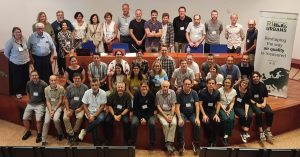Project Description

The EU funded Horizon-2020 RI-URBANS project (Research Infrastructures Services Reinforcing Air Quality Monitoring Capacities in European Urban & Industrial AreaS; https://riurbans.eu; 1 October 2021 – 30 September 2025) final the 4th Science Meeting took place in a hybrid mode during 8-9 September 2025 in Barcelona, Spain. It has been organized by the Spanish National Research Council (CSIC), the Institute for the Atmospheric and Earth System Research of the University of Helsinki (INAR-UHEL), and the Aerosol, Clouds and Trace Gases Research Infrastructure (ACTRIS) – European Research Infrastructure (ERIC). The CSIC hosted this event at the Residència D’Investigadors premises in the cultural centre of the city of Barcelona. About 100 persons pre-registered for the event, and in total about 50 persons attended onsite, and about 40 persons attended online.
The first day, 8 September, started with the Introductory plenary session. A series of invited talks was delivered starting from an overview of the RI-URBANS project final results (by the RI-URBANS coordinators Xavier Querol, CSIC & Tuukka Petäjä, UHEL), Implementation of new pollutants in the new Air Quality (AQ) Directive (by Lucia Bernal Saukkonen, DG ENV-EC), the network of National Air Quality Reference Laboratories (AQUILA) view on the new AQ pollutants in the new AQ Directive (by Annette Borowiak, Joint Research Center – European Commission, JRC-EC, AQUILA), the ACTRIS support for the implementation of the new AQ Directive (by Tuukka Petäjä, UHEL), Data quality control for new AQ pollutants (by Alfred Wiedensohler, the representative of the ACTRIS – European Center for Aerosol Calibration and Characterization, CAIS-ECAC), Current view of the World Health Organization (WHO) on the new pollutants (by Wenlu Ye, WHO), How RI-URBANS results may be used by AQMNs (by Guido Lanzani, Agenzia Regionale per la Protezione dell’Ambient, ARPA Lombardía), Innovative methods for AQ monitoring and modelling at transport hotspots (by Kostas Eleftheriadis, National Centre For Scientific Research Demokritos, NSCR-Demokritos), and Approach to numerical modelling of oxidative potential with the System for Integrated Modeling of Atmospheric Composition (SILAM) Chemical Transport Model (CTM) (by Mikhail Sofiev, Finnish Meteorological Institute). This session followed by session on the final results of the RI-URBANS WorkPackages (WP), where the WPs Leaders presented summaries of the results achieved during the project lifetime, with discussion including beyond the project lifetime. At the end, the RI-URBANS Steering Committee (WPs Leaders, Data Manager, Innovation Manager, Risk manager) meeting took place.
During the second day, 9 September, a series of presentations about the RI-URBANS’ Service Tools (STs): Final Versions & How to Upgrade (if needed) was delivered. These included the following:
Protocols for the measurement of novel AQ pollutants
- ST1 Ultrafine-Particle Number Size Distributions (UFP-PNSD)
- ST2 Black Carbon (BC)
- ST3 Offline and online particulate matter (PM) speciation
- ST4 Oxidative potential of particulate matter (OP of PM)
- ST5 Volatile Organic Compounds (VOCs)
- ST6 Ammonia (NH3)
Methodologies for vertical profiles of pollutants and meteorology
- ST7 Measurements of boundary level height
- ST8 Measurements of vertical profiles of aerosols
- ST9 Measurements of IAGOS vertical profiles by commercial aircrafts
Methodologies for source apportionment receptor modelling
- ST10 Source apportionment of PM based on offline and online PM speciation
- ST11 Source apportionment of UFP, BC, OP and VOCs using receptor modelling
Methodologies for urban mapping of novel AQ pollutants
- ST12 Deterministic urban modelling of fine PM and PNC
- ST13 Mapping ultrafine particles and citizen science
Methodologies for evaluating the health effects of novel AQ pollutants
- ST14 Evaluation of health effects of novel AQ parameters
Obtaining emission inventories for novel AQ pollutants
- ST15 First UFP-PNSD and non-exhaust vehicle PM EU emission
Modelling methodologies for novel AQ pollutants
- ST16 UFP-PNSD multiscale modelling
At the end, final discussions followed with a wrap up including on how member states are building supersites.
The RI-URBANS project:
- Deliverables and Milestones are publicly available at: https://riurbans.eu/project/#deliverables-and-milestones
- Guidance documents for the Service Tools are available at: https://riurbans.eu/project/#service-tools
- Peer-reviewed scientific publications (with corresponding DOI-links) are available at: https://riurbans.eu/results/#publications
- Open data (to download and explore databases) are available at: https://riurbans.eu/results/#open-data
On the third day, 10 September, the final RI-URBANS’ stakeholder webinar took place online. For this event, more than 320 persons pre-registered, and more than160 attended. This webinar described the final results of the RI-URBANS project, with a major focus on the Service Tools (STs) and the added value of implementing these STs. These give guidance for surface and profile measurements, source apportionment, health assessment, mapping, emission inventories, and modelling. These may support the implementation of the supersites and new pollutants in the Air Quality Directive (EU) 2024/2881 together with ACTRIS-ERIC. A series of delivered presentations included: Concept and results from RI-URBANS, the Service Tools; Roles of ACTRIS for the implementation of STs; Supporting publication of Guidance Documents by the AXA Research Fund; Urban mapping tools, representativity of the AQ monitoring sites; Measurements of oxidative potential; Health effects of the new pollutants; and Modelling of new pollutants; followed by discussions.
Note that the previous 3rd Annual Science Meetings of the RI-URBANS project took place in a hybrid mode during 25-26 September 2024 in Helsinki, Finland, which gathered in total 135 participants. The presentations from the 3rd Science Meeting are publicly available at the RI-URBANS public website. And the presentations from the last 4th Science Meeting will be also soon publicly available.
News from the RI-URBANS PCT team: Xavier Querol, Marta Monge, CSIC & Tuukka Petäjä, Nahid Atashi, Alexander Mahura, UHEL
